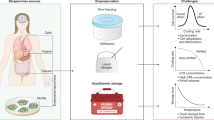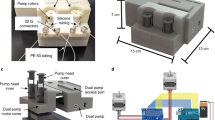Abstract
Often referred to as a living fossil, the American horseshoe crab, Limulus polyphemus, is one of the most-studied invertebrate animals in the world. It has served as a model in Nobel Prize–winning eye research, and researchers use a component of its blood to detect bacterial contamination in medical devices and drugs. The authors review the conditions necessary for housing these animals in the laboratory.
This is a preview of subscription content, access via your institution
Access options
Subscribe to this journal
We are sorry, but there is no personal subscription option available for your country.
Buy this article
- Purchase on Springer Link
- Instant access to full article PDF
Prices may be subject to local taxes which are calculated during checkout









Similar content being viewed by others
References
Shuster, C.N., Jr. in Physiology and Biology of the Horseshoe Crabs: Studies on Normal and Environmentally Stressed Animals (eds. Bonaventura, J., Bonaventura, C. & Tesh, S.) 1–52 (Alan R. Liss, New York, 1982).
Smith, S.A., Berkson, J.M. & Barratt, R.A. Horseshoe crab (Limulus polyphemus) hemolymph, biochemical and immunological parameters. Proc. Int. Assoc. Aquatic Anim. Med. 33, 101–102 (2002).
Walls, E.A. & Berkson, J. Effect of blood extraction on the mortality of the horseshoe crab, Limulus polyphemus. VA J. Sci. 51(3), 195–198 (2000).
Berkson J.M. & Shuster, C.N., Jr. The horseshoe crab: the battle over a true multiple use resource. Fisheries 24(11), 6–10 (1999).
Botton, M.L. & Ropes, J.W. The horseshoe crab, Limulus polyphemus, fishery and resource in the United States. Mar. Fish. Rev. 49(3), 57–60 (1987).
Horseshoe Crab Technical Committee. Status of the Horseshoe Crab (Limulus polyphemus) Population of the Atlantic Coast (Atlantic State Marine Fisheries Commission. Washington, DC, 1998).
Myers, J.P. Sex and gluttony on the Delaware Bay. Nat. Hist. 95(3), 68–77 (1986).
Redmond, J.R., Jorgensen, D.D. & Bourne, G.B. in Biomedical Applications of the Horseshoe Crab (Limulidae) (ed. Cohen, E.) 133–146 (Alan R. Liss, New York, 1979).
Chamberlain, S.C. & Wyse, G.A. An atlas of the brain of the horseshoe crab Limulus polyphemus. J. Morphol. 187(3), 363–386 (1986).
Freadman, M.A. & Watson, W.H. Gills as possible accessory circulatory pumps in Limulus polyphemus. Biol. Bull. 177(3), 386–395 (1989).
Hartline, H.K., Wagner, H.G. & Ratcliff, F. Inhibition in the eye of Limulus. J. Gen. Physiol. 39(5), 651–673 (1956).
Hartline, H.K. & Ratliff, F. Inhibitory interaction of receptor units in the eye of Limulus. J. Gen. Physiol. 40(3), 357–376 (1957).
Edwards, S.C. & Pierce, S.K. Octopamine potentiates intracellular Na+ and Cl− reductions during cell volume regulation in Limulus exposed to hypoosmotic stress. J. Comp. Physiol. [B] 156(4), 481–489 (1986).
Dragolovich, J. & Pierce, S.K. Comparative time course of inorganic and organic osmolyte accumulation as horseshoe crabs (Limulus polyphemus) adapt to high salinity. Comp. Biochem. Physiol. A Physiol. 102(1), 79–84 (1992).
Sekiguchi, K., Yamamichi, Y. & Costlow, J.D. Horseshoe crab development studies I. Normal embryonic development of Limulus polyphemus compared to Tachypleus tridentatus. Prog. Clin. Biol. Res. 81, 53–73 (1982).
Bonaventura, J., Bonaventura, C. & Tesh, S. Physiology and Biology of Horseshoe Crabs; Studies on Normal and Environmentally Stressed Animals (Alan R. Liss, New York, 1982).
Cohen, E. Biomedical Applications of the Horseshoe Crab (Limulidae) (Alan R. Liss, New York, 1979).
Kropach, C. in Biomedical Applications of the Horseshoe Crab (Limulidae) (ed. Cohen, E.) 103–106 (Alan R. Liss, New York, 1979).
Norvitsky, T.J. Discovery to commercialization: the blood of the horseshoe crab. Oceanus 27(1), 13–18 (1984).
Mikkelsen, T. The Secret in the Blue Blood (Science Press, Beijing, 1988).
Rudloe, J. The effect of heavy bleeding on mortality of the horseshoe crab, Limulus polyphemus, in the natural environment. J. Invert. Pathol. 42(2), 167–176 (1983).
Walls, E.A., Berkson, J. & Smith, S.A. The horseshoe crab, Limulus polyphemus: 200 million years of existence, 100 years of study. Rev. Fish. Sci. 10(1), 39–73 (2002).
Owen, R. On the anatomy of the American king-crab, (Limulus polyphemus Latr.). Trans. Linnean Soc. Lond. 28, 459–506 (1873).
Sherman, R.G. Muscle attachments in horseshoe crab walking legs. Biol. Bull. 146(1), 88–99 (1974).
Shuster, C.N., Jr. in Clinical Applications of the Limulus Amoebocyte Lysate Test (ed. Prior, R.B.) 15–25 (CRC Press, Boca Raton, FL, 1990).
Hall, W.R. MAS Bulletin: The Horseshoe Crab (University of Delaware, Newark, DE, 1995).
French, K.A. in Biomedical Applications of the Horseshoe Crab (Limulidae) (ed. Cohen, E.) 61–71 (Alan R. Liss, New York, 1979).
Brown, G.G. & Clapper, D.L. in Laboratory Animal Management: Marine Invertebrates 268–290 (National Academy Press, Washington, DC, 1981).
Shuster, C.N., Jr. On Morphometric and Seriological Relationships Within the Limulidae, with Particular Reference to Limulus polyphemus (L.). Thesis, New York University, New York, NY (1958).
Laughlin, R. The effects of temperature and salinity on larval growth of the horseshoe crab, Limulus polyphemus. Biol. Bull. 164(1), 93–103 (1983).
Gonzalez-Uribe, J.F. & Ortega-Salas, A.A. Environmental factors in rearing eggs and larvae of Limulus polyphemus L. under laboratory conditions. Special Publ. Eur. Aquacult. Soc. 15, 264–265 (1991).
Botton, M.L. Diet and food preferences of the adult horseshoe crab, Limulus polyphemus in Delaware Bay, New Jersey, USA. Mar. Biol. 81(2), 199–207 (1984).
Bullis, R.A. in Techniques in Fish Immunology Vol. 3 (eds. Stolen, J.S. et al.) A9–A10 (SOS Publications, Fair Haven, NJ, 1994).
Bursey, C.R. Histological response to injury in the horseshoe crab, Limulus polyphemus. Can. J. Zool. 55(7), 1158–1165 (1977).
Clare, A.S., Lumb, G. Clare, P.A. & Costlow, J.D. A morphological study of wound repair and telson regeneration in postlarval Limulus polyphemus. Invert. Reprod. Dev. 17(1), 77–87 (1990).
Bang, F.B. A bacterial disease of Limulus polyphemus. Bull. Johns Hopkins Hosp. 98(5), 325–351 (1956).
Leibovitz, L. & Lewbart, G.A. in The American Horseshoe Crab (eds. Shuster, C.N., Barlow, R.B. & Brockmann, H.J.) 245–275 (Harvard University Press, Cambridge, MA, 2004).
Leibovitz, L. & Lewbart, G.A. A green algal (chlorophycophytal) infection of the dorsal surface of the exoskeleton and associated organ structures in the horseshoe crab (Limulus polyphemus). Biol. Bull. 173(2), 430 (1987).
Leibovitz, L. Cyanobacterial diseases of the horseshoe crab (Limulus polyphemus). Biol. Bull. 171(2), 481–482 (1986).
Chen, S., Hong, S., Chen, Y. & Yang, Y. Cultivation of horseshoe crab amebocytes [Japanese]. Gaoxiong Yi Xue Ke Xue Za Zhi. 5(9), 516–521 (1989).
Stunkard, H.W. Microphallid metacercaria encysted in Limulus. Biol. Bull. 99(2), 347 (1950).
Stunkard, H.W. Observations on the morphology and life-history of Microphallus n. sp. (Trematoda: Microphallidae). Biol. Bull. 101(3), 307–318 (1951).
Stunkard, H.W. Natural hosts of Microphallus limuli. J. Parasitol. 39, 225 (1953).
Stunkard, H.W. The asexual generation, life cycle, and systemic relations of Microphallus limuli Stunkard, 1951 (Trematoda: Digenea). Biol. Bull. 134(2), 332–343 (1968).
Groff, J.F. & Leibovitz. L. A gill disease of Limulus polyphemus associated with triclad turbellarid worm infections. Biol. Bull. 163, 392 (1982).
Kawakatsu, M. Redescription of an ectoparasitic marine triclad, Bdelloura candida (Girard, 1850)(Burbellaria; Tricladida; Maricola), collected from the American horseshoe crab, Limulus polyphemus. Bull. Biogeographic Soc. Jpn. 44, 183–198 (1989).
Ryder, J.A. Observations on the species of planarians on Limulus. Am. Nat. 16, 48–51 (1882).
Wheeler, W.M. Syncoelidium pellucidum, a new marine triclad. J. Morphol. 9, 167–194 (1894).
Botton, M.L. The gill books of the horseshoe crab (Limulus polyphemus) as a substrate for the blue mussel (Mytilus edulis). Bull. NJ Acad. Sci. 26(1), 26–28 (1981).
Turner, L.L., Kammire, C. & Sydlik, M.A. Preliminary report; composition of communities resident on Limulus carapaces. Biol. Bull. 175(2), 312 (1988).
Deaton, L.E. & Kempler, K.D. Occurrence of the ribbed mussel, Geukensia demissa, on the book gills of the horseshoe crab, Limulus polyphemus. Nautilus 103(1), 42 (1989).
Grant, D. in Limulus in the Limelight: A Species 350 Million Years in the Making and in Peril? (ed. Tanacredi, J.T.) 135–145 (Kluwer Academic/Plenum Publishers, New York, 2001).
Landy, R.B. & Leibovitz, L. A preliminary study of the toxicity and therapeutic efficacy of formalin in the treatment of Triclad turbellarid worm infestations in Limulus polyphemus. Proceedings of the Annual Meeting of the Society of Invertebrate Pathology. Ithaca, NY. (1983).
Author information
Authors and Affiliations
Corresponding author
Ethics declarations
Competing interests
The authors declare no competing financial interests.
Rights and permissions
About this article
Cite this article
Smith, S., Berkson, J. Laboratory culture and maintenance of the horseshoe crab (Limulus polyphemus). Lab Anim 34, 27–34 (2005). https://doi.org/10.1038/laban0705-27
Received:
Accepted:
Issue Date:
DOI: https://doi.org/10.1038/laban0705-27
This article is cited by
-
Draft genomic and transcriptome resources for marine chelicerate Tachypleus tridentatus
Scientific Data (2019)
-
Effect of starvation on the energy budget of two Asian horseshoe crab species: Tachypleus tridentatus and Carcinoscorpius rotundicauda (Chelicerata: Xiphosura)
Marine Biology (2011)
-
Grasshoppers in research and education: methods for maintenance and production
Lab Animal (2007)



